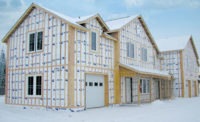Insulation, which manages the passage of heat in a building system, is critical to the construction of a functional, cost-effective and energy-efficient structure. Builders frequently specify one of two types of rigid foam insulation, EPS or XPS. Each has advantages that may make it more suitable for a particular use, but considerations of thermal and moisture protection and fire resistance are essential to determining their value as “green” building materials.
What Are the Differences?
Extruded Polystyrene, or XPS, is made in a continuous extrusion process that produces a closed-cell form of foam insulation. Expanded Polystyrene, EPS, is manufactured by expanding spherical beads in a mold, then using heat and pressure to fuse the beads together.
Thermal and Moisture Protection
R-value measures a material’s resistance to heat transfer. The higher the R-value, the better the material can insulate. The usual procedure for testing a material’s R-value is ASTM C518, Standard Test Method for Steady-state Thermal Transmission Properties by Means of the Heat Flow Meter Apparatus, which requires a technician to measure the thermal resistance of a specimen placed between a cold plate and a hot plate.
Rigid foam insulation delivers excellent R-values for such a thin product, but not all rigid foam offers the same thermal performance. EPS is more widely used in insulated concrete forms (ICF), structural insulated panels (SIP), and Exterior Insulation and Finishing Systems (EIFS). It has the lowest average R-value of rigid foam insulation, typically R-4 per inch. The actual R-value of EPS depends on its density with higher-density foams having higher R-values in the range of 3.6 to 4.2 per inch. Less expensive EPS, such as that sold at home improvement warehouse stores, is 1 pound density per cubic foot, appropriately called Type-I density EPS. Type-I products typically offer about R-3.9 per inch or R-7.8 at 2-inches.
Type-II EPS, rated at 1.5 pounds nominal density, has an R-value between R-4.15 and R-4.2 per inch. A 2-inch-thick sheet would be R-8.3 to R-8.4. Type-II EPS is what most distributors will ship unless otherwise specified. In fact, many contractors refer to Type-II EPS as standard density, not “high density.”3
XPS, at about R-5 per inch, has only a slightly better thermal performance than EPS. The thermal insulation performance of EPS and XPS in identical densities is quite close. However, EPS with the same level of density is less expensive. XPS is usually used in areas where materials with less density are needed or where XPS, which is not produced below a certain density, is not applicable. In such cases, the use of EPS as a less dense material would provide the required insulation at a much lower cost.
Perm Rating Comparison
A “perm rating,” short for “permeance,” is a standard measure of a material’s water vapor permeability. The higher the number, the more easily gaseous water can diffuse through the material. When using XPS insulation in wall assemblies, the perm rating drops from 1.1 to 0.7 to 0.6 as the thickness increases from 1- to 2- to 3-inches. Material with a lower perm rating is better at retarding the movement of water vapor. If the perm rating is low, the material is considered a vapor retarder. Materials with perm ratings are labeled as vapor barriers. The rating correlates with substrate longevity.
The general rule is, the better the vapor barrier and the drier the conditions, less venting is required. In colder regions vapor barriers should be installed on the warm-in-winter side of walls, while in humid areas, such as the Gulf Coast and Florida, it should be placed on the exterior walls. A vapor barrier on the warm side should be constructed with a venting path on the cold side of the insulation because no vapor barrier can keep all water, most commonly rain, out of a structure.
A perm rating of less than 0.1 is considered a Class I impermeable vapor retarder and a vapor barrier. A rating between 0.1 and 1 is considered a Class II semi-permeable vapor retarder and a perm rating between 1 and 10 is a Class III permeable vapor retarder. Any product with a perm rating greater than 10 is highly permeable and not for use as a vapor retarder. Unfaced 1-inch-thick XPS has a perm rating around 1, and is rated as semi-permeable. The perm rating for EPS is 5. More information is available from the U. S. Department of Energy about vapor barriers and vapor retarders.
XPS is manufactured in both an unfaced form or with different plastic facings. Either way XPS is considered a vapor retarder, not a vapor barrier.
Although higher densities of EPS have a greater compressive strength than lower densities, EPS is never as strong as XPS and is more susceptible to crumbling at the edges and to other job site damage. That’s why EPS is rarely used for wall sheathing.
When applied as exterior wall insulation over sheathing, EPS should be installed over a water resistive barrier, such as house wrap. This type of rigid foam is usually not made with a facer, which means workers must handle it with care.
Insulation and Fire Performance
Reduced thermal capability at elevated temperatures is one example of how these insulations differ. EPS will soften at a temperature of only 165 degrees Fahrenheit, which will reduce its thermal performance capability. At 212 degrees Fahrenheit, EPS begins to melt and drip, which can result in the complete loss of the insulation’s thermal efficiency. According to the EPS Industry Alliance, under certain fire conditions, EPS will ignite when exposed to an open flame. The temperature for transfer ignition is usually around 680 degrees Fahrenheit (360 degrees Celsius).
Although foam insulation is fairly difficult to ignite, when it does, the burning will readily spread over the exposed surface of EPS and continue to burn until the EPS is consumed. EPS is an oil-based product that generates a dense, black smoke that results in the production of harmful gasses, including carbon monoxide, monostyrene, hydrogen bromide (a corrosive acid) and other aromatic compounds.
Conversely, XPS, part of an insulating foam category called thermoplastics, is formed from non-cross linked polymers and can be reheated and remolded. This makes XPS less rigid. It becomes pliable when exposed to a temperature of about 165° F. XPS insulation meets its melting point typically between 200 and 210 degrees Fahrenheit, though in extreme infernos, it too will be consumed by fire and emit noxious fumes.
As of mid-2015, the European Union banned HBCD (hexabromocyclododecane), the brominated flame retardant used in all polystyrene building insulation, both XPS and EPS. Considerable funds have been invested in developing a next-generation flame retardant for polystyrene insulation. The big question is whether the replacement flame-retardants being considered by the polystyrene industry are halogenated compounds (containing bromine or chlorine). Chemist and Environmental Building News Advisory Board member Arlene Blum, Ph.D., an expert on health and environmental hazards of halogenated flame retardants, is pleased with the ruling. Sticking with a halogenated compound “could mean we’re moving from one toxin to another,” says Blum, who suggests looking at the bigger questions about flame resistance and safety. “It’s time to ask what the fire safety benefits of these flame retardants are.”
Water Resistance
XPS and EPS have fundamental differences that are essential to determining which is a better choice for wall applications that require high resistance to moisture intrusion. The water absorption rate by total immersion for XPS is listed at 0.3 percent maximum by volume, compared to 2.0 to 4 percent for EPS, depending on product density–a substantial difference to be taken into account when specifying the job.
The closed-cell structure of XPS makes it more resistant to water. Although EPS beads are closed-cell and hydrophobic, they are also surrounded by voids. The voids are responsible for the higher water absorption volume found in finished EPS board. The blowing agent used in EPS is quickly replaced by air and, paired with the voids, result in an EPS insulation product with lower thermal resistance capability when compared to XPS. An EPS product with higher density would have fewer voids and thus less potential for water absorption and an increase in thermal resistance.
A higher potential for water absorption means a higher potential for the growth of mold. Most EPS products sold at home improvement warehouses absorb more water than XPS products.
The Green Factor
A building’s “green” rating is of concern for owners as well as those in the design-build sector. While both XPS and EPS have green features, an important factor to consider is the blowing agent used to create the foam.
EPS is often produced with Pentane, which has a very low Global Warming Potential. XPS uses hydrochlorofluorocarbons (HCFCs) as the blowing agent, which has a high Global Warming Potential. XPS has shown to lose some of its R-value over time, as the gas slowly escapes.1 XPS manufacturers have begun to shift to newer blowing agents with a Zero Ozone Depleting formula. To know if the selected product is of the newer type, consult the manufacturer’s Safety Data Sheet.
EPS is considered an excellent choice for green building designs because it offers the environmental advantages of energy efficiency, recyclable content, resistance to mold and indoor environmental quality. Both EPS and XPS can help meet green building localized manufacturing goals, which helps to reduce the impact of transportation. With hundreds of plant locations in North America, both forms of insulation usually are available from a local manufacturer.
The use of EPS in innovative applications improves the performance of a building’s envelope. During installation, EPS applications have been shown to consistently reduce both jobsite waste and labor costs. Environmental benefits last through the service life of a building with higher insulating properties that result in measurable savings. In addition to the environmental benefits of EPS, the energy needed to make it can be less than that used to produce non-foam insulating materials. A study conducted by the EPS Industry Alliance compared EPS to fiberglass insulation and found the energy required to produce foam insulation is 24 percent less than that needed to make enough fiberglass to achieve an equivalent R-value at a representative volume.2
For more than 60 years, EPS has been free of both CFCs and HCFCs. It provides stable R-values that do not need to be adjusted as years pass. EPS offers mold resistance and receives a favorable ASTM C1338 rating, which determines the ability of insulation and its facing to resist fungal growth under conditions favorable for its development.
Builders can earn green building credits by specifying EPS foam insulation in many point categories, such as recycled and recyclable content, energy efficiency, indoor air quality, sustainable job sites and general innovation. LEED and other green building accreditation groups recognize numerous system applications, including SIPS and ICFs that use EPS, as providing significant environmental advantages.
XPS has many favorable attributes and properties that separate it from other types of foam insulation. XPS can be installed below slabs, below grade foundations and walls and is often specified when higher compressive strength, greater moisture resistance and elevated thermal resistance in the presence of water are required.
Because XPS contains the flame retardant HBCD, and its blowing agents have a very high global warming potential, most green builders will use other products. Though, recycled XPS is widely available and cheaper than new EPS or XPS. The C02 impact already occurred, making reclaimed foam the greenest of all foam insulation products.
Making the Choice
Both EPS and XPS are effective forms of exterior wall insulation. A solid grasp of the differences between the two materials is essential to making the best specification choice. The selected insulation will most likely be in service for decades. Replacing wall sheathing can be quite an expensive project.
Footnotes:
1. Building Green Vol.2, No.1 / buildinggreen.com
2. EPS Industry Alliance, 2012 Report / espindustry.org
3. Green Building Advisor, 2015 Forum / greenbuildingadvisor.com














